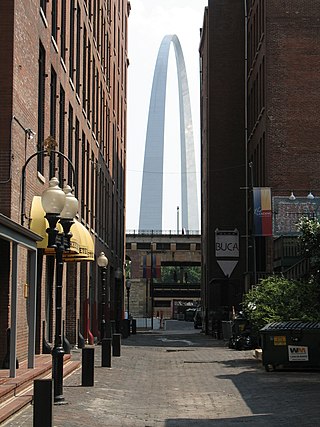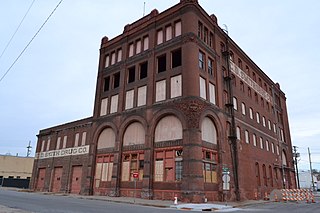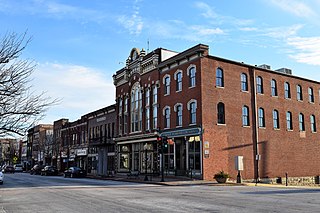
The Washington Avenue Historic District is located in Downtown West, St. Louis, Missouri along Washington Avenue, and bounded by Delmar Boulevard to the north, Locust Street to the south, 8th Street on the east, and 18th Street on the west. The buildings date from the late 19th century to the early 1920s. They exhibit a variety of popular architectural styles of those years, but most are revival styles or in the commercial style that would later come to be known as the Chicago School of architecture. Most are large multi-story buildings of brick and stone construction, built as warehouses for the St. Louis garment district. Many have terra cotta accents on their facades. After World War II, the decline in domestic garment production and the preference for single-story industrial space led to many of the buildings being vacant or underused due to functional obsolescence.

The architecture of St. Louis exhibits a variety of commercial, residential, and monumental architecture. St. Louis, Missouri is known for the Gateway Arch, the tallest monument constructed in the United States. Architectural influences reflected in the area include French Colonial, German, early American, European influenced, French Second Empire, Victorian, and modern architectural styles.

There are nine historic districts in Meridian, Mississippi. Each of these districts is listed on the National Register of Historic Places. One district, Meridian Downtown Historic District, is a combination of two older districts, Meridian Urban Center Historic District and Union Station Historic District. Many architectural styles are present in the districts, most from the late 19th century and early 20th century, including Queen Anne, Colonial Revival, Italianate, Art Deco, Late Victorian, and Bungalow.

The Greenwich Avenue Historic District is a historic district representing the commercial and civic historical development of the downtown area of the town of Greenwich, Connecticut. The district was listed on the National Register of Historic Places on August 31, 1989. Included in the district is the Greenwich Municipal Center Historic District, which was listed on the National Register the year before for the classical revival style municipal buildings in the core of Downtown. Most of the commercial buildings in the district fall into three broad styles, reflecting the period in which they were built: Italianate, Georgian Revival, and Commercial style. The district is linear and runs north–south along the entire length of Greenwich Avenue, the main thoroughfare of Downtown Greenwich, between U.S. Route 1 and the New Haven Line railroad tracks.

Joseph A. Shannon (1859-1934), known in at least one source as John A. Shannon, was an architect in Devils Lake, North Dakota.

Edmond J. Eckel was an architect in practice in St. Joseph, Missouri, from 1872 until his death in 1934. In 1880 he was the founder of Eckel & Mann, later Eckel & Aldrich and Brunner & Brunner, which was the oldest architectural firm in Missouri prior to its eventual dissolution in 1999.

The Park-to-Park Residential Historic District in Fort Madison, Iowa, United States, was listed on the National Register of Historic Places in 2014. The historic district is located to the north of the Downtown Commercial Historic District, generally between Central Park on the west and Old Settler's Park on the east. Both parks are contributing sites. For the most part the district is made up of single family homes built in the late 19th and early 20th centuries. Some of these homes were built as rental properties, while others became so in later years. The Albright House and the Chief Justice Joseph M. Beck House are contributing properties, and they are also individually listed on the National Register. There are also duplexes and a few small scale apartment buildings in the district.
Hohman Avenue Commercial Historic District is a national historic district located at Hammond, Lake County, Indiana. The district encompasses 15 contributing buildings in the central business district of Hammond. It developed between about 1904 and 1956, and includes notable example of Romanesque Revival, Classical Revival, and Colonial Revival style architecture. Notable buildings include Knott's Apartments (1904), Emmerling Ambulance Garage (1918), Emmerling Building (1918), St. Joseph's Roman Catholic Church Complex, LaSalle Hotel, OK Building (1913), and the Hammond National Bank.

Corby–Forsee Building, also known as the Corby Building, is a historic commercial building located at St. Joseph, Missouri. It was designed by the architectural firm Eames & Young and built in 1910. It is a 12-story, reinforced concrete building faced with yellow brick and grey-buff terra cotta detailing at the first, second, eleventh and twelfth floor levels. A one-story addition was designed by the architecture firm of Eckel & Aldrich and constructed in 1927 to house the trade halls of the St. Joseph Grain Exchange.

St. Joseph's Commerce and Banking Historic District is a national historic district located at St. Joseph, Missouri. The district encompasses 39 contributing buildings in the central business district of St. Joseph. Between 1859 and 1950, various architectural styles were developed, including Italianate, Classical Revival, and Streamline Moderne. Located in the district are the separately listed German-American Bank Building, Corby-Forsee Building, Missouri Theater, Missouri Theater Building, and Missouri Valley Trust Company Historic District. Other notable buildings include the Ballinger Building (1889), Commerce Building, First National Bank of St. Joseph, Lehman's, Plymouth Building (1908), and the United Building (1917-1918) by the architecture firm of Eckel & Aldrich.

Missouri Valley Trust Company Historic District, formerly known as the Market Square Historic District, is a national historic district located at St. Joseph, Missouri. The district encompasses six contributing buildings in the central business district of St. Joseph. It developed between about 1859 and the 1860s, and includes representative examples of Renaissance Revival style architecture. The primary building is the Bank of the State of Missouri (1859).

South Fourth Street Commercial Historic District is a national historic district located at St. Joseph, Missouri. The district encompasses 25 contributing buildings in an industrial/commercial section of St. Joseph west of the central business district. It developed between about 1861 and 1929, and includes representative examples of Italianate, Classical Revival, and Renaissance Revival style architecture. Notable buildings include a number of commercial blocks and warehouse/light manufacturing facilities some of which were designed by architect Edmond Jacques Eckel (1845–1934).

Wholesale Row, also known as the Wholesale Row Historic District, is a national historic district located at St. Joseph, Missouri. The district originally encompassed five contributing buildings in an industrial / commercial section of St. Joseph on the western edge of the central business district. The Noyes-Norman Building (1872) on 3rd Street has been demolished. It developed between about 1872 and 1884, and includes representative examples of Italianate style architecture. The remaining buildings are the R.L. McDonald and Co. Building (1880), Englehart-Winning Co. North Building (1884), Englehart-Winning Co. South Building (1880), and Brittain-Richardson and Co. Building (1882). The remaining buildings were all designed by the architect Edmond Jacques Eckel (1845–1934).

The City Hall Park Historic District encompasses one of the central economic, civic, and public spaces of the city of Burlington, Vermont. Centered on City Hall Park, the area's architecture encapsulates the city's development from a frontier town to an urban commercial center. The district was listed on the National Register of Historic Places in 1983.

Missouri State Capitol Historic District is a national historic district located at Jefferson City, Cole County, Missouri. It encompasses 122 contributing buildings in the central business district of Jefferson City. The district developed between about 1850 and 1950, and includes representative examples of Classical Revival, Late Victorian, Queen Anne, Mission Revival, and Modern Movement style architecture. Located in the district are the separately listed Missouri State Capitol, Lohman's Landing Building, Cole County Historical Society Building, Cole County Courthouse and Jail-Sheriff's House, Missouri Governor's Mansion, and Tergin Apartment Building. Other notable buildings include the St. Peter's Roman Catholic Church complex (1881-1883), Margaret Upshulte House, Broadway State Office Building (1938), Supreme Court of Missouri (1905-1906), U.S. Post Office and Courthouse (1932-1934), Lohman's Opera House, Missouri State Optical, First United Methodist Church (1900), Carnegie Public Library (1901), Temple Beth El (1883), and Joseph and Susie Kolkmeyer House.

Jackson Park Historic District is a nationally recognized historic district located in Dubuque, Iowa, United States. It was listed on the National Register of Historic Places in 1986. This is primarily a residential area, with some institutional and commercial buildings, located north of the central business district. The city originally developed just to the south of here. The Cathedral Historic District represents the oldest residential neighborhood in Dubuque, and began to house the working-class people closer to the docks. Once the Jackson Park area opened for development the city's wealthier residents built their homes here. Architectural styles rang from the vernacular, which are found mainly along the bluff, to the high style found mainly along Main and Locust Streets. Most of the houses were built from the mid to the late 19th century. The Andrew-Ryan House (1873) was individually listed on the National Register. Most of the institutional architecture are churches, which include St. John's Episcopal Church (1878) and St. Patrick's Catholic Church (1878). Central High School, no longer extant, was located across from Jackson Park, and it was also individually listed on the National Register before its demise. The Carnegie-Stout Public Library (1902) is located on the south side of the district.
Bonnots Mill Historic District is a national historic district located at Bonnots Mill, Osage County, Missouri. It encompasses 98 contributing buildings in the central business district and surrounding residential sections of Bonnots Mill. The district developed between about 1840 and 1942, and includes representative examples of Bungalow / American Craftsman and I-house architecture. Located in the district is the separately listed Dauphine Hotel. Other notable buildings include the Bonnots Mill School (1889), Henry Dieckriede House, Bonnots Mill United Methodist Church (1915), Bank of Bonnots Mill (1907), Bonnet's Mill Hotel / Krautman's Store, Meyer-Morfeld Milling Company, United States Post Office, St. Louis Parish Church and Rectory (1907), and St. Louis Parish School.

The Sedalia Commercial Historic District is a national historic district located at Sedalia, Pettis County, Missouri. It encompasses 102 contributing buildings in the central business district of Sedalia. The district developed between about 1870 and 1959, and includes representative examples of Italianate, Romanesque Revival, and Art Deco architecture. Located in the district are the separately listed Hotel Bothwell, Building at 217 West Main Street, and Missouri/Sedalia Trust Company. Other notable buildings include the First United Methodist Church (1888-1891), Pettis County Courthouse (1924), Anheuser Busch Bottling Works, the New Lona Theater (1920), Citizens National Bank Building, Third National Bank (1929), Federal Building (1930), Montgomery Ward Building (1936), the Uptown Theatre (1936), Missouri Pacific Depot, and Central Presbyterian Church.

North Third Street Historic District is a national historic district located at Louisiana, Pike County, Missouri. The district encompasses 61 contributing buildings, one contributing site, and contributing structure in a predominantly residential section of Louisiana. It developed between about 1843 and 1935 and includes representative examples of Greek Revival, Gothic Revival, Italianate, Queen Anne, Colonial Revival, and Bungalow/American Craftsman style architecture. Located in the district are the separately listed Louisiana Public Library and Luce-Dyer House. Other notable buildings include the William C. Hardin House, James H. Johnson House, Edward G. McQuie House, St. Joseph's Catholic Church (1874), and Frank Boehm, Jr. House.

The Deer Lodge Central Business Historic District, in Deer Lodge, Montana, in Powell County, Montana, is a historic district which was listed on the National Register of Historic Places in 2008.






















